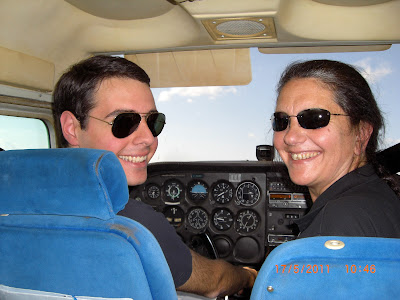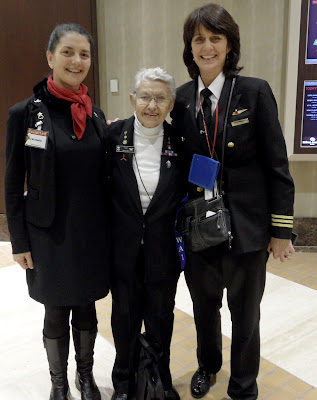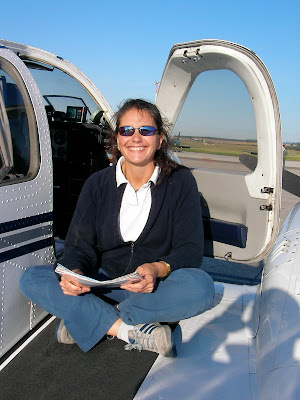Friday's Fabulous Flyer
MICHELLE BASSANESI
Chief Operations Officer / Professional Pilot and
Instructor / Board Member for non-profit / Aviation Education Consultant
Michelle, a student at
Embry-Riddle Aeronautical University Worldwide, working toward her Bachelor of Science in Aeronautics Degree
with minors in Aviation Safety and Management is on not only in the Alpha Sigma
Lambda Honor Society, but on the Dean’s List with a G.P.A. of 4.0/4.0, too. Studying Crew Resource Management and Multi Crew Coordination, she
has her Master CFI accreditation and has
earned various Leadership Awards and Scholarships in recognition of exceptional
achievements.
She
inspired 300 women in growth, leadership, and empowerment during the
Leadership and Female Empowerment Workshop in Rome, the Leadership Development
for Women In Aviation Conference in Johannesburg, and the Women Fly program in
Seattle.
She’s
Engaged, inspired, and educated 60 young women to pursue their dreams
in aviation and beyond during the Women Soar, You Soar program. She has provided women the tools necessary to
develop their pilot careers and leadership through the Ninety Nines
Professional Pilot Leadership Initiative.
Michelle
was an elected board member after less than six months as a member and transformed PWA – Professional Women's
Association of Rome into a non-profit organization and successfully set up
online payment and reservation solutions. She has facilitated as International Liaison in
Europe, aviation support groups for WAI – Women in Aviation International, and
SAWIA – Southern African Women in Aviation.
What is so amazing about Michelle—besides
the fact she is truly an amazing and giving woman—is she started this stage of
her life when she was 38 years old, and a single parent.
Michelle began her aviation adventure in 2000 when she started flying at the age of 38. Please join me as we learn more about what makes this woman tick.
Karlene:
At 38-years old, most people are established in their careers. Why did you wait
so long to fly?
Michelle:
"I came to the point in my life when I finally realized I could start living my
dream today.”
hugging the seneca one before taking her commercial multi instrument checkride
hugging the seneca one before taking her commercial multi instrument checkride
Karlene: I know being a single parent and starting you flying career later in life has got to be filled with obstacles. What has been your greatest struggle has been?
Michelle: “Juggling non-aviation and aviation
related work and study life together with life’s challenges. Recovering my
mobility after a bad accident that left me three months in a wheel chair in
1993, being a single mum, moving from Australia to Italy at the age of 15,
losing my “little” sister to cancer 3 years ago, just to name a few.”
Karlene: I am so sorry for all
your struggles, and your loss. Sometimes I wonder if we are just being tested to
see if we are willing to give up.
But you never do, and prove despite all obstacles that we can fulfill
our dreams.
One of the most common questions,
or concerns, with people who are thinking and dreaming about doing exactly what
you are doing—flying later in life— is the question and fear that they may be
too old. The fact that you started flying at 38 years old is amazing. What
would you tell others about following your path?
Michelle: Just do it! Believe in yourself, stay focused, and have fun.
The examiner congratulates Michelle on passing her initial JAA flight instructor certificate
Karlene: Sounds simple. But that
seriously is the power behind success. I know that both you and your daughter
are in college at the same time, and both anticipating graduation in 2015. What
will you do after your graduate?
Michelle: PHD together with you on aviation safety and in CRM training improvements, be hired as aviation friendly airport executive, continue flying around the globe in jets (I will be hired as a pilot before I graduate hopefully), at 85 I will fly helicopters and at 105 I will write a book.
Michelle and her daughter at a summer concert
Karlene: Michelle, I have no doubt
you will fulfill all these dreams despite the pending struggles that we both
know are ahead. And now we’ve said it. 2015 you will be my catalyst to get me
back into school.
flight planning on the wing
Michelle is applying for the Delta
Air Lines Aviation Maintenance Management/Aviation Business Management
Scholarship. Delta Air Lines will award a $5,000 scholarship to a student
currently enrolled in an Associate or Baccalaureate degree in Aviation
Maintenance Management or Aviation Business Management. I’m hoping this will go
to a most deserving woman—Michelle Bassanesi
Michelle at Women Soar 2012
Please join me in wishing her the
best luck on receiving this honor. And this scholarship couldn’t come at a
better time. Her daughter has been facing some serious medical issues, and this
may be the year that Michelle might have to postpone renewing her licenses, and
take some time off from school. Her dedication and love of the industry,
passion for flight, and all she’s done for the hundreds of women pursing their
dreams, I hope that won’t be the case.
We are all with you Michelle.
Enjoy the journey and 2013 we will come and visit you in Rome.
Enjoy the Journey!
XO Karlene
Flight For Safety: 95,388 words, first draft.
























































